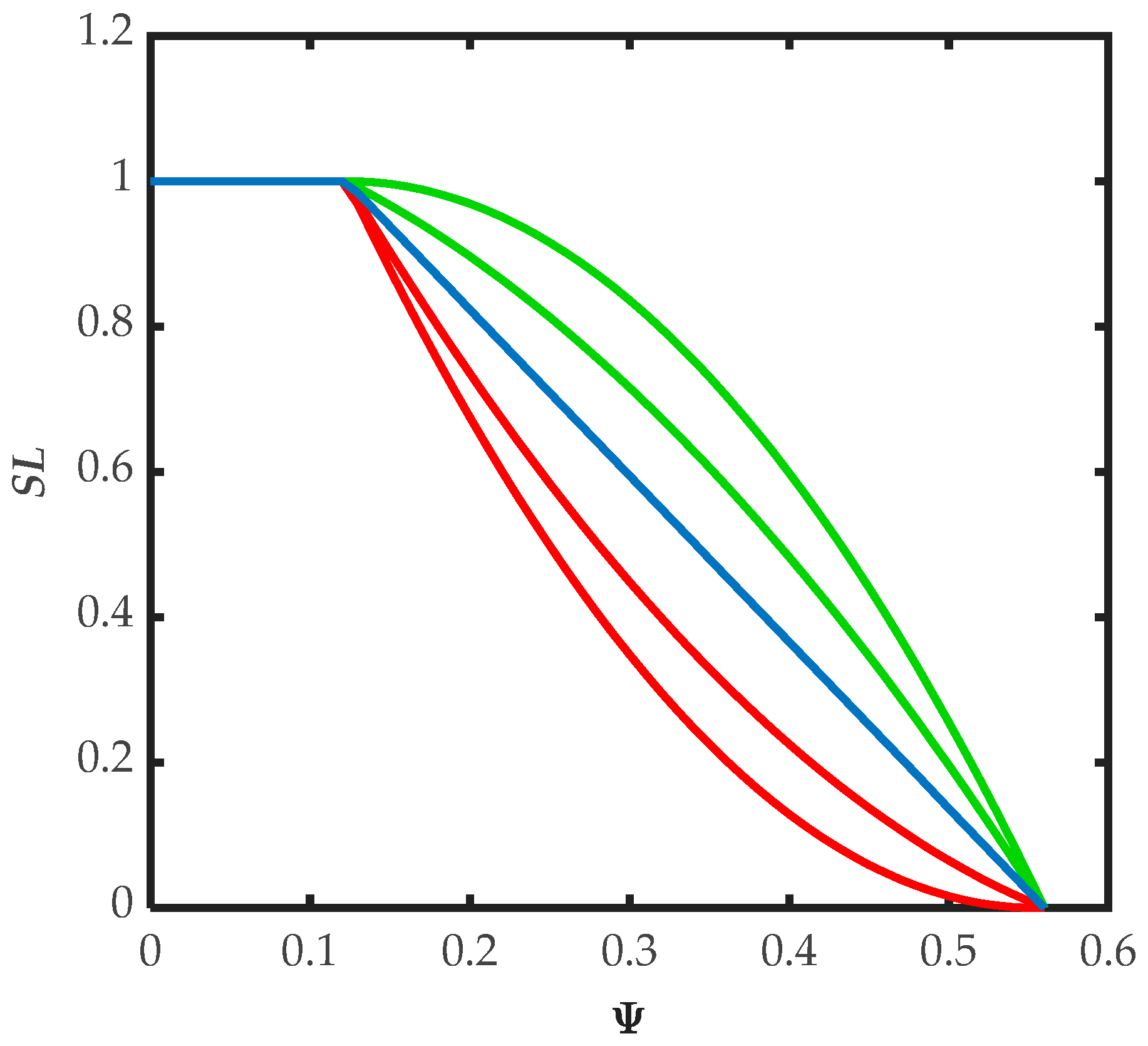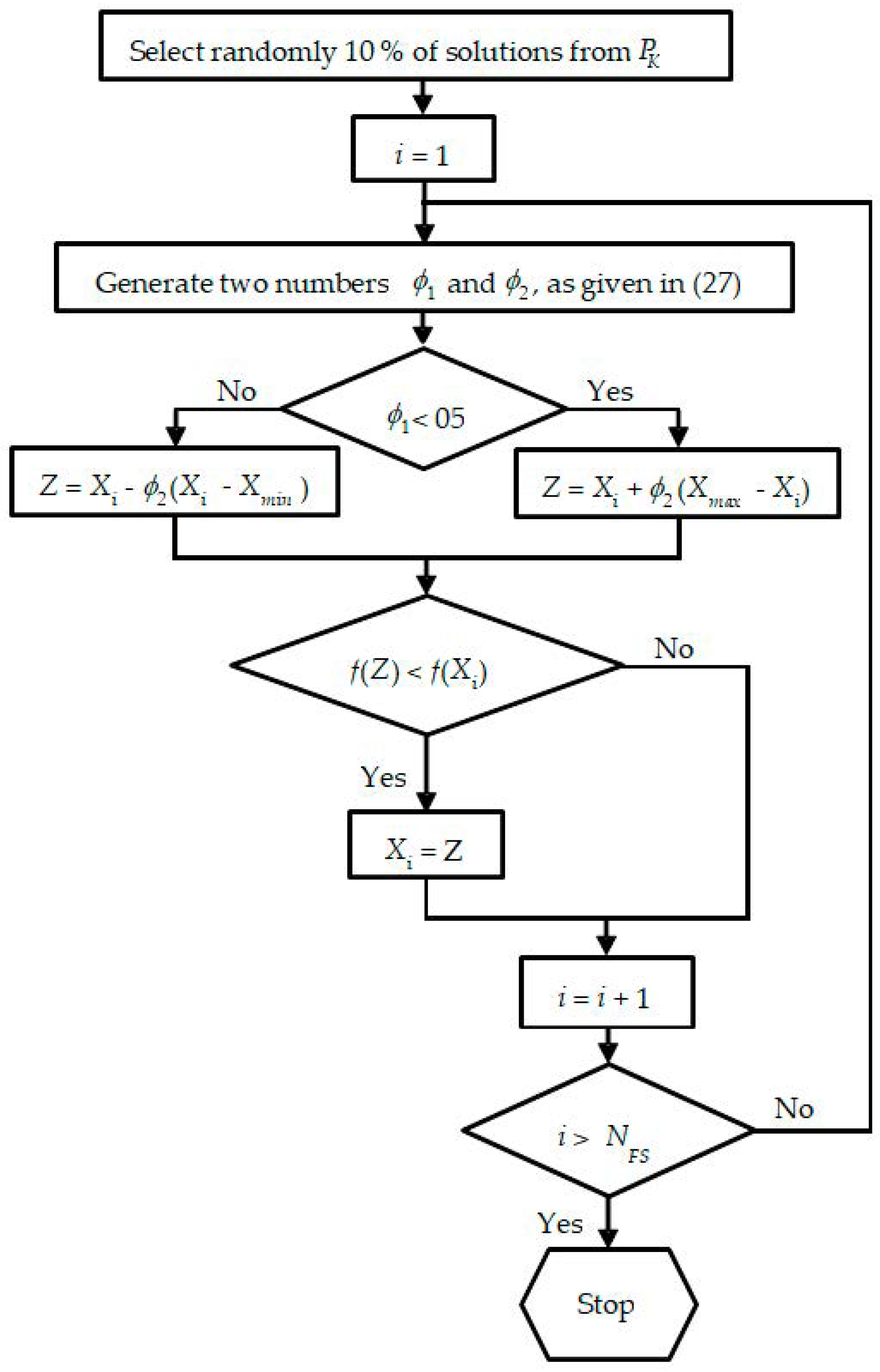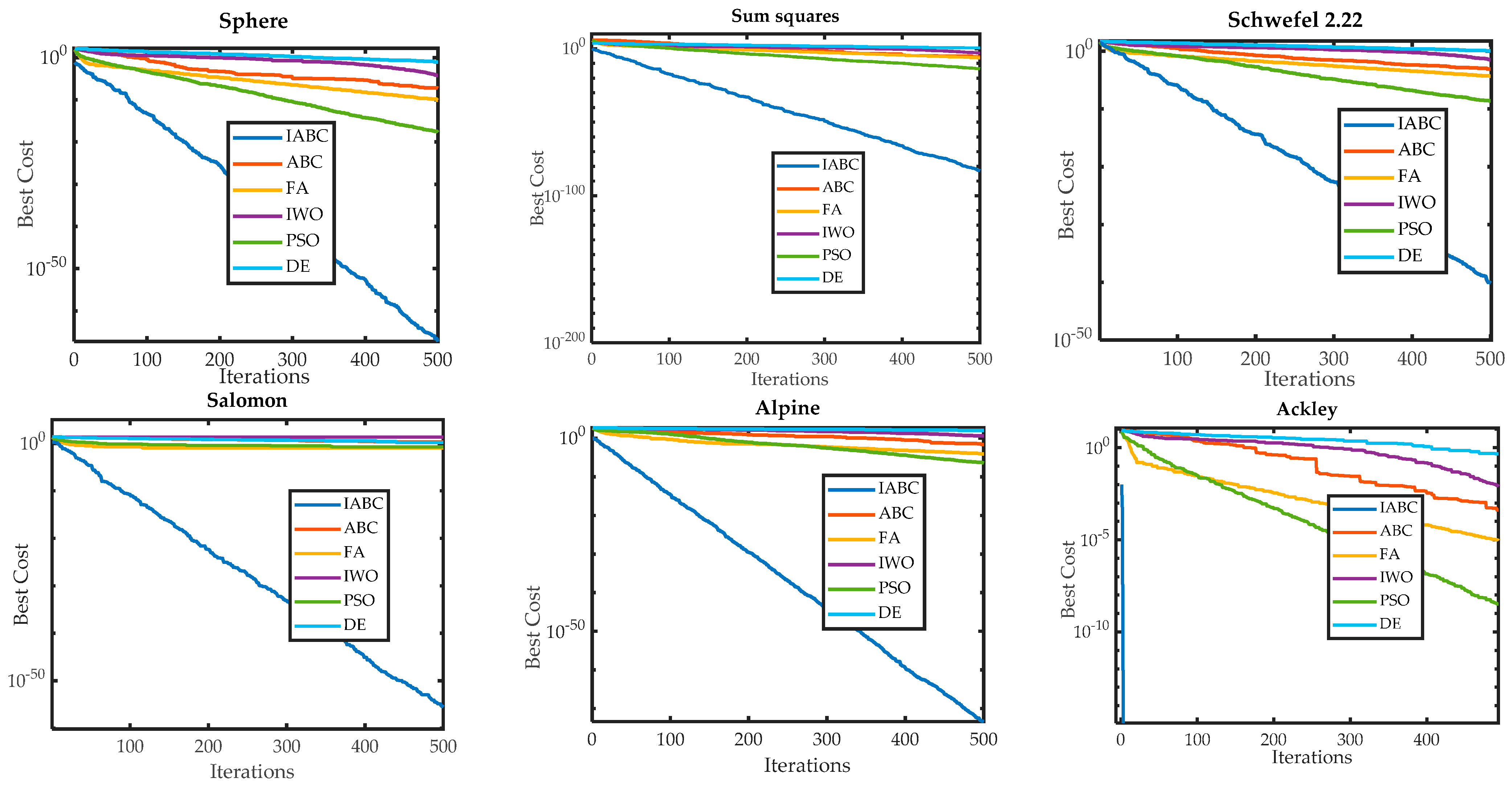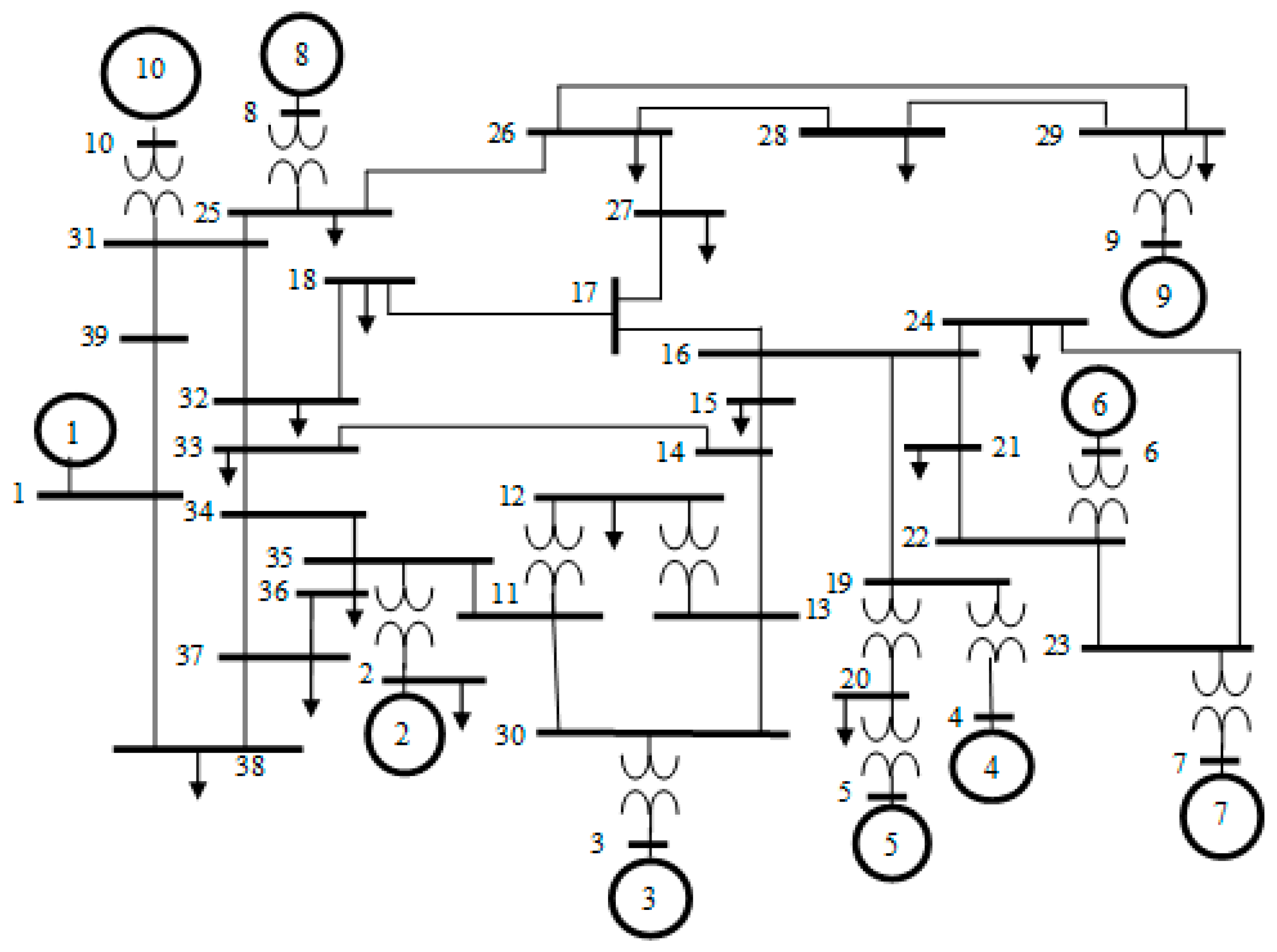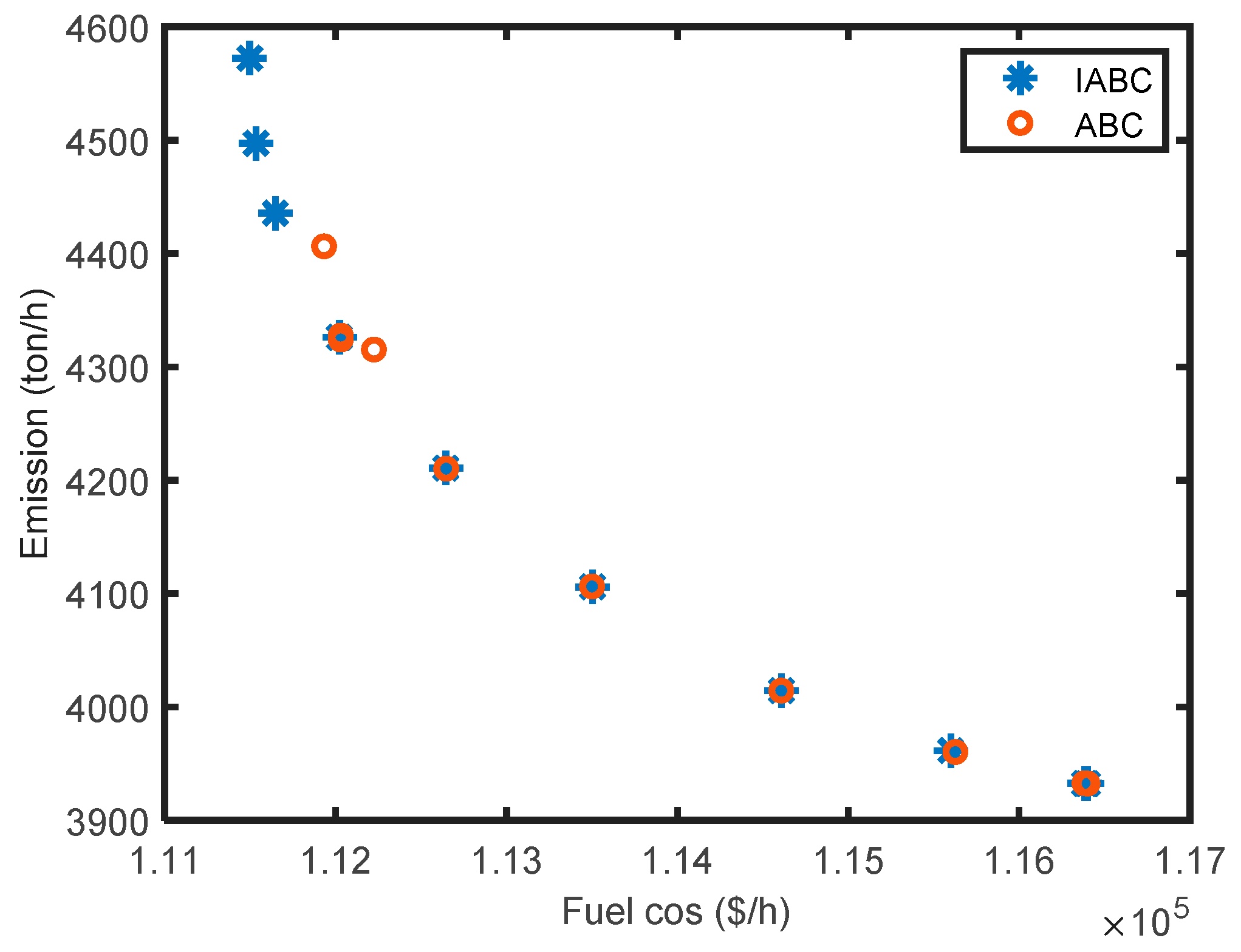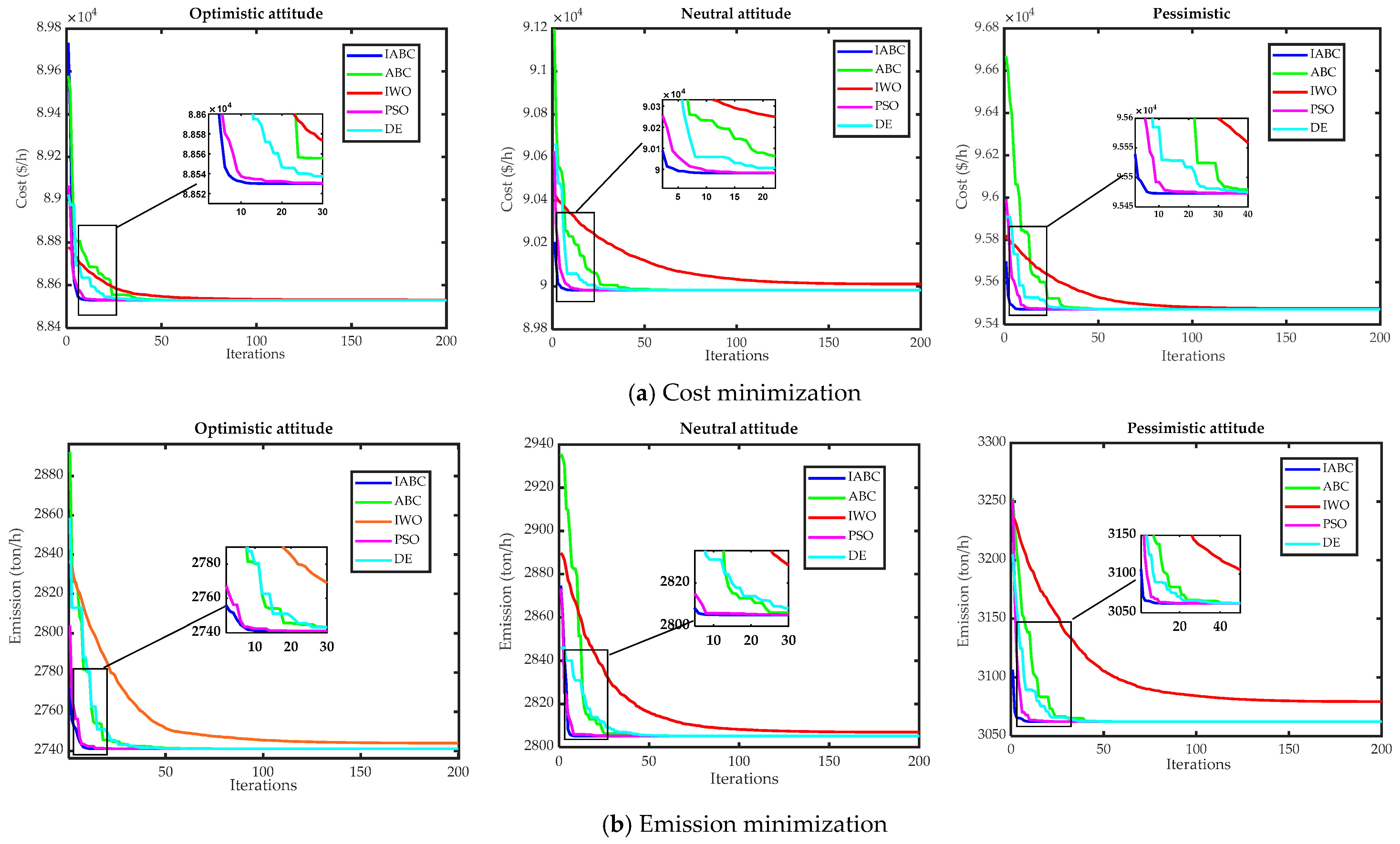1.1. Research Background and Related Works
Economic dispatch problem (EDP) is a static optimization problem that aims to find the optimal combination of power outputs of generating units so as to operate the power network in the most economical way [
1]. This optimal distribution must obviously respect the power balance constraint and production limits of the power plants. The decision variables of the EDP are, therefore, power outputs of generating units. Generally, the generation of electricity from fossil fuels is accompanied by emission of harmful gases. Thus, emissions released by thermal units should be taken into account in the power generation scheduling of the power network. Unfortunately, the minimum fuel cost does not necessarily correspond to the minimum emissions and vice-versa [
2], which is proved in various research studies [
2,
3,
4,
5]. To handle this problem, system operators are called to simultaneously consider both fuel cost and emissions in the load dispatch problem. This problem is called combined economic environmental dispatch (CEED). The purpose of CEED is to exploit thermal units with minimum production cost and minimum emissions while satisfying the total power demand and operational constraints, such as generation capacity and valve point loading effects (VPLEs) [
3]. However, when VPLEs are considered, sinusoidal forms are added to the fuel cost function, and the CEED becomes highly nonlinear and non-convex. In the meantime, with the gradual exhaustion of fossil resources worldwide and the increase of the demand for energy, renewable energy, such as wind energy, has been incorporated into the existing power networks. As a matter of fact, wind energy sources have the advantage of reducing polluting gas emissions and conserving irreplaceable fuel reserves. However, this deployment of the wind power (WP) sector is not without technical problems linked to its insertion into the power network. Among other things, the difficulties imposed by the variability of wind power compromise the balance between production and consumption, the quality of energy and the network safety [
4]. Therefore, when high WP penetration is included into power networks, impact of WP intermittency has to be considered in the CEED modeling. A conventional strategy based on the average values of WP is used to describe WP availability [
5]. Although this method appears easy for implementation, it results in high probabilistic infeasibility coming from describing WP through the average of random variables [
6].
Generally, the CEED has been formulated as a conflicting bi-objective optimization problem. Hence, the resolution of this kind of problem leads to a set of optimal solutions, called non-dominated solutions or Pareto solutions, instead of a single solution [
7]. Therefore, decision makers should seek suitable strategies for extracting a compromise solution from among the Pareto solutions set. From a mathematical point of view, approaches applied for solving CEED can be classified into three categories. In the first category, fuel cost and emissions have been combined in a single objective function by the linear weighted sum or normalizing fuel cost and emissions by using price penalty factors [
8,
9,
10]. The set of Pareto solutions may be obtained by running the selected optimization algorithm several times. The second category also converts the CEED into a single objective problem but by incorporating the emissions in the system constraints [
11,
12]. However, decision makers do not have any idea concerning tradeoffs between cost and emissions. The third category involves both functions simultaneously where the Pareto set is generated in one run of the opted optimization algorithm [
13].
From the literature review [
5,
7], it was found that various optimization techniques have been applied to solve the CEED where some works have incorporated renewable energy sources in the problem. Traditional methods, such as quadratic programming [
14], linear programming [
15], interior point method [
16], and ε-constrained technique [
17], have been criticized for their sensitivity to the problem constraints and initial solutions. Moreover, these techniques are iterative and may fail to converge to the global optima.
Over the last two decades, various meta-heuristic techniques have been suggested to overcome the drawbacks of conventional methods. Meta-heuristic techniques are usually inspired by nature, whether found in physics, such as simulated annealing; in biology, such as genetic algorithms; or in ethology, such as ant colony algorithms. The most popular meta-heuristics are genetic algorithms (GA), differential evolution (DE), particle swarm optimization (PSO), artificial bee colony (ABC), tabu search (TS), simulated annealing (SA), gravitational search algorithm (GSA), firefly algorithm (FA), and invasive weed optimization (IWO). Without a doubt, various meta-heuristic algorithms have been investigated in the literature to examine the CEED problem. For instance, in [
18], a GSA-based method has been proposed for minimizing the production cost. The same method has been implemented by Guvenc et al. [
19] for the CEED problem, where cost and emissions have been combined in a single objective function by using price penalty factors. A version of the NSGAII algorithm, modified by adding a dynamic crowding distance, has been used to minimize simultaneously the fuel cost and emissions for static load [
20]. The proposed scheme has been evaluated on various test systems. In [
21], a flower pollination algorithm-based methodology was suggested for solving the CEED problem incorporating VPLE constraints. The adopted methodology has been executed on various test cases. Mason et al. [
22] have proposed three variants of PSO algorithm for the issue of the dynamic economic emission dispatch (DEED). The proposed variants of PSO are the standard PSO, the PSO with avoidance of worst locations (PSO AWL), and the PSO with a gradually increasing directed neighborhood (PSO GIDN). The performances of the adopted algorithms have been tested against the NSGAII. The DEED has been solved also in [
23] by using an improved version of the multi-objective evolutionary algorithm where the algorithm has been implemented on the 6-unit, 10-unit, and 14-unit systems.
At present, the incorporation of renewable energy in the CEED has become the fundamental issue in the power dispatch problems. Hence, some formulations of the CEED problem have considered the inclusion of renewable energy, such as WP and photovoltaic (PV) systems [
24,
25]. Jin et al. [
24] have developed a model to include wind farms in the CEED problem where the stochastic output of the farm is described by the overestimation and underestimation cost of available WP. In [
5], the effect of WP intermittency on the DEED results is described by a chance constraint, as suggested in a pioneering work by Liu and Xu [
6]. In the same way as in [
5], a chance-constraint-based model for the dynamic EDP with wind farm was investigated in [
25], where the problem was converted into a deterministic optimization problem, and then, an improved version of PSO was used for its solution. Large scale WP penetration in the optimum allocation of real power generation was considered also in [
26], where the random characteristics of WP was described by the Weibull distribution function, and multi-objective PSO (MOPSO) was used for the simultaneous minimization of the fuel cost and emissions.
In order to avoid security implications in power grids due to the volatility of WP, another pioneer formulation of the power dispatch with wind plant has been developed in [
27]. In [
27], the authors added the risk level in the dispatch problem as an objective function to be minimized. The risk level was expressed using fuzzy membership functions in terms of wind power running cost. These membership functions were employed to describe the dispatcher’s attitudes toward WP integration. Wang and Singh [
28] have also applied this pioneering formulation for the economic dispatch where the PSO technique has been used for its resolution. In [
29], the economic dispatch with WP was solved using a multi-objective PSO-based method, where the operational cost and risk level functions were incorporated in the problem formulation as objective functions. A fuzzy linear membership function has been suggested for the risk calculation. However, the minimization of the risk corresponds to minimum WP penetration. Therefore, it is advised to seek a trade-off between operation cost and system security [
30]. In order to keep WP generation within permissible values, the probability of the power balance that cannot be met may also be taken into consideration in the problem constraints. Thus, the problem becomes more complex due to the stochastic variables and the addition of new nonlinear constraints. Moreover, the final solutions will depend on the dispatcher’s attitude. Consequently, the selection of the suitable optimization method that may be used for the resolution of this kind of problem appears to be a critical task.
Recently, the artificial bee colony (ABC) algorithm introduced by Karaboga [
31] has been successfully employed for solving many issues in various engineering domains, such as in power system operation, sensor placement, and neural network training [
32]. The ABC algorithm is inspired by the food tracking of honey bees. At its core, the ABC algorithm consists of four phases, which are the (i) initialization phase, (ii) employed bee phase, (iii) onlooker bee phase, and (iv) scout bee phase. All of these phases are based on random variables. According to the literature review, the ABC algorithm, similar to other stochastic-based techniques, has been criticized for its slow convergence, and it can be trapped in local optima, especially for multimodal problems with multiple optima [
33]. To overcome these drawbacks linked to the ABC algorithm, various variants of ABC have been appearing during recent years [
33,
34,
35]. Although these ABC variants have improved the performance of the standard ABC, the majority of them have failed to solve the slow convergence and the diversity issues addressed in the original algorithm. Recently, chaotic maps have been employed, together with evolutionary algorithms, to improve its performance. For instance, chaos has been inserted in the reproduction operators of GA to enhance the population diversity [
36]. In [
37], chaos theory has been applied to generate initial populations for DE and GA methods.
As do some other research works [
33,
34], this paper presents a new attempt to further improve the robustness and performance of the standard ABC algorithm. In the developed optimization technique, chaos theory is integrated into the ABC algorithm in order to improve the exploration and exploitation abilities of the classical ABC and, on the other hand, to avoid the convergence into a local optimum. This improved version of ABC (IABC) is proposed to deal with the multimodal CEED problem including wind farms.
1.2. Contributions
The present study proposes an improved version of the ABC algorithm based on chaos theory to deal with the stochastic CEED problem with WP. In order to take into account the random characteristics of WP, the problem is converted into a chance constraint optimization problem, and fuel cost and emission functions are combined in a single objective function by using the weighted sum method. The optimal WP to be incorporated in the grid is determined in such a way that the system security is kept within certain limits fixed based on the dispatcher’s attitudes. The system security is represented by various fuzzy membership functions in terms of the probability that power balance cannot be met.
In the suggested IABC method, first, the generation of the initial population was based on chaotic maps. Therefore, initial solutions with high quality could be furnished. Then, all random numbers involved in the employed bee, onlooker bee, and scout bee phases were substituted by chaotic sequences. Note that the Ikeda map [
38] was used for these two steps. To provide an appropriate balance between exploration and exploitation abilities and improve the global convergence of the algorithm, a chaotic-based local search was embedded at the end of each cycle of the fundamental ABC. In this step, chaotic sequences were generated using the Zaslavskii map [
39]. To the best of our knowledge, the proposed technique has not been used for solving the dispatch problems or any other optimization problems.
The performance of this new algorithm was first assessed on various unimodal and multimodal benchmark functions, well used in the literature for assessing optimization techniques. To further test the effectiveness and robustness of the proposed IABC for solving the non-convex CEED problem including WP, two practical power systems were used where all systems’ constraints were considered. Simulation results showed that the proposed IABC outperformed other meta-heuristic techniques reported in the literature, such as DE [
40], PSO [
9], IWO [
41], FA [
42], ABC [
31], kernel search optimization (KSO) [
3], OGHS [
43], and NGPSO [
44].
The remaining sections of this paper are organized as follows. In
Section 2, the problem formulation and the research methodology are developed. In
Section 3, numerical examples based on benchmark functions and power system tests are investigated to validate the suggested model and the optimization method. Finally, the conclusion is presented in
Section 4.
